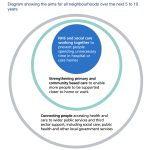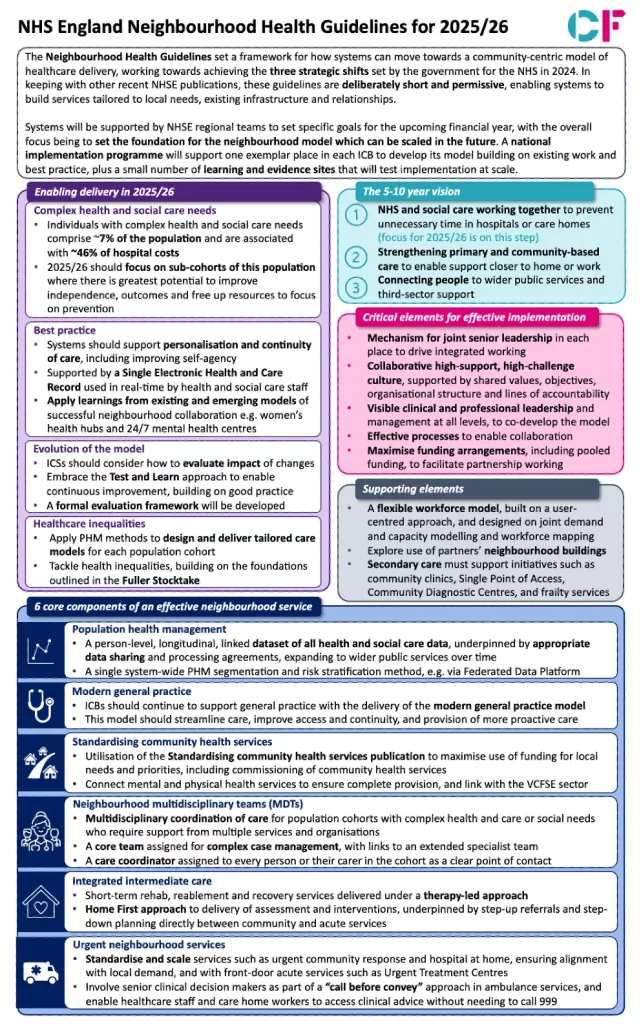The third sector has an integral role to play when it comes to Neighbourhood Health.
National Guidance issued on 29 January 2025 from NHS England is a positive step in the right direction as the importance of third sector is recognised in relation to the health of our communities.
However, it doesn’t go far in enough in making explicit the role of the third sector; our involvement at every level and coproduction with communities – saying – ‘the guidelines are deliberately short and permissive about how neighbourhood health should be implemented, setting out a framework for action that can be tailored to local needs.’ extract from the Neighbourhood health guidelines 2025/26 on NHS.uk.
The need to balance a national mandate with trust in local insight is understandable and reflects the fact that different parts of the UK have vastly different VCSE sectors, in terms of maturity, connection with ICBs, infrastructure support etc.
Summary of the guidelines:
Carnall Farrar (healthcare consultants) have summarised the 2025/26 Neighbourhood Health Guidelines into a handy snapshot (image below):
Summary of Neighbourhood Health Guidelines 2025/26 (pdf)
Extract from the NHSE Neighbourhood Health Guidelines:
Neighbourhood health reinforces a new way of working for the NHS, local government, social care and their partners, where integrated working is the norm and not the exception. Some places have already made progress in developing an integrated local approach to NHS and social care delivery. The full vision for the health system will be set out in the 10 Year Health Plan, including proposals to help make this emerging vision for neighbourhood health a reality, informed by existing work and public, staff and stakeholder engagement.
The document sets out guidelines to help integrated care boards (ICBs), local authorities and health and care providers continue to progress neighbourhood health in 2025/26 in advance of the publication of the 10 Year Health Plan. The appendix provides more specificity around the initial 6 components of neighbourhood health to create a common understanding of what lies at its core, but the guidelines are deliberately short and permissive about how neighbourhood health should be implemented, setting out a framework for action that can be tailored to local needs.
Neighbourhood health aims to create healthier communities, helping people of all ages live healthy, active and independent lives for as long as possible while improving their experience of health and social care, and increasing their agency in managing their own care. This will be achieved by better connecting and optimising health and care resource through 3 key shifts at the core of the government’s health mission:
- from hospital to community – providing better care close to or in people’s own homes, helping them to maintain their independence for as long as possible, only using hospitals when it is clinically necessary for their care
- from treatment to prevention – promoting health literacy, supporting early intervention and reducing health deterioration or avoidable exacerbations of ill health
- from analogue to digital – greater use of digital infrastructure and solutions to improve care
All parts of the health and care system – primary care, social care, community health, mental health, acute, and wider system partners – will need to work closely together to support people’s needs more systematically, building on existing cross-team working, such as primary care networks, provider collaboratives and collaboration with the voluntary, community, faith and social enterprise (VCFSE) sector. In some parts of the country this is already happening, and much can be learned from these experiences. Integrated care system leaders will need to work with partners across local communities, together creating a collaborative high-support, high-challenge culture, to develop a shared vision and outcomes, define population boundaries for neighbourhood health and introduce joint accountability arrangements.
In the coming months, drawing on learnings from existing work, the focus will be on creating the national and local conditions for different ways of working. The diagram below shows the aims for all neighbourhoods over the next 5 to 10 years. For 2025/26, through the standardisation and scaling of the initial 6 components, we are asking systems to focus on the innermost circle to prevent people spending unnecessary time in hospital and care homes. As core relationships between the local partners grow stronger, we expect systems to focus increasingly on the outer circles. This will involve exploring their own ways of building or reinforcing links with wider public services, the third sector and local communities to fully transform the delivery of health and social care according to local needs:
Image text:
- NHS and social care working together to prevent people spending unnecessary time in hospital or care homes.
- Strengthening primary and community based care to enable more people to be supported closer to home or work.
- Connecting people accessing health and care to wider public services and third sector support, including social care, public health and other local government services.
Image of the Carnal Farrar summary of Neighbourhood Health Guidelines 2025/26 (pdf):

